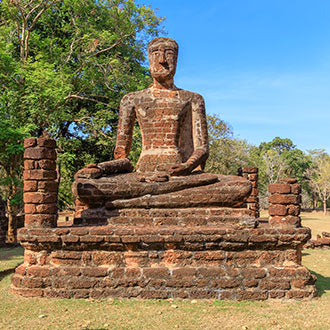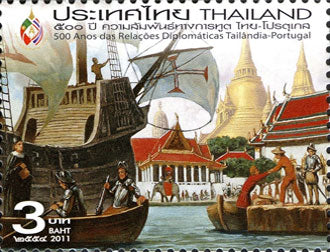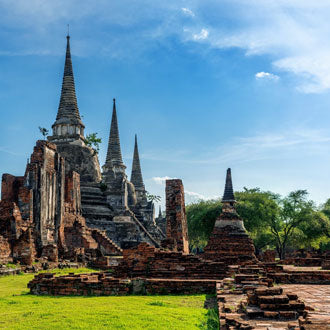My shopping cart
Your cart is currently empty.
Continue Shopping
Nestled along the banks of the Chao Phraya River, the ancient city of Ayutthaya stands as a testament to Thailand's rich history and cultural heritage.
Once a magnificent capital and a bustling hub of commerce and culture, Ayutthaya's ruins now paint a captivating picture of its former grandeur.
We will take you on a journey of rediscovery, as we unveil the timeless appeal of Ayutthaya's majestic ruins.

The Kingdom of Ayutthaya was founded in 1350 and served as the second capital of the Siamese Kingdom. Named after Ayodhya, the Indian city from the epic Ramayana, Ayutthaya was the capital from the 14th to the 18th century. Ayutthaya was strategically positioned on an island encompassed by three rivers, establishing a connection between the city and the sea.
The selection of this site was based on its advantageous location above the tidal bore of the Gulf of Siam during that era, effectively deterring potential attacks from foreign naval vessels. Additionally, this location provided a natural safeguard against seasonal floods, further ensuring the protection of the city.
For over four centuries, it thrived as a hub of trade, culture, and diplomacy, attracting merchants, scholars, and envoys from around the world. The city's strategic location at the confluence of rivers facilitated commerce and interaction, earning it a reputation as a cosmopolitan center of Southeast Asia.

Due to its strategic positioning, Ayutthaya became a central trading hub. The city's rise as a flourishing trade center was marked by its ability to facilitate commerce between the East and West.
Merchants from China, India, Japan, and Europe converged on Ayutthaya's shores, bringing with them a diverse array of goods, ideas, and cultures. This vibrant trade network enriched the city's economy and allowed it to flourish.
Beyond trade, Ayutthaya's diplomatic importance was equally profound. Its reputation as a prosperous and powerful kingdom attracted envoys from neighboring nations and distant lands.
These diplomatic interactions played a crucial role in shaping the city's alliances, policies, and global standing. Ayutthaya's diplomacy was instrumental in maintaining peace and stability in the region.

The convergence of traders from around the world transformed Ayutthaya into a cultural crossroads. The city became a melting pot where diverse traditions, languages, cuisines, and artistic styles intermingled.
This cultural exchange was not limited to material goods; it extended to ideas, religion, and societal norms. It left an indelible mark on the city's identity, shaping its customs and artistic expressions.
Wandering through the ruins or museums, you'll encounter artifacts that reflect this vibrant blend of cultures. Chinese-style ceramics and European glassware serve as reminders of Ayutthaya's global connections. The city's inclusivity has left a lasting impact that still resonates in contemporary Thai society.

Today, Ayutthaya's landscape is dominated by the ruins of its once-splendid structures. The ancient city was renowned for its impressive layout and design, featuring a series of interconnected temples, monasteries, and royal compounds linked by canals and roads.
The ruins offer a mesmerizing blend of architectural styles, reflecting the diverse influences that have shaped Ayutthaya throughout the centuries. The ruins of Ayutthaya stand as evidence of the exceptional architectural skills displayed during its era. As you venture through the historical sites, you will encounter iconic buildings that once graced the city's landscape.
The "prang" towers, characterized by their imposing pyramid-like structures, are a defining feature of Ayutthaya's unique architecture. These towers, found at locations like Wat Phra Si Sanphet, held significance not only as places of worship but also as representations of the grandeur and magnificence evident in the city's architectural achievements. Ayutthaya boasts numerous architecturally unique structures, which can make it a challenge to fully explore the city in just one day. However, if you find yourself with limited time and a desire to visit these ancient ruins, there are certain places that you should not miss.
The majestic Wat Phra Si Sanphet, constructed in 1491, this temple once housed an impressive 16-meter tall Buddha image adorned with gold. Unfortunately, in 1767, the Burmese set fire to the statue as part of their attempt to extract the valuable gold from its surface.

As a result of this destructive act, both the temple and image were lost forever. The three chedis that stand side by side on these grounds are dedicated to three kings and are often captured in photographs. Wat Phra Ram offers another opportunity for exploration with its graceful 14th-century structure surrounded by reflective pools.
Inside you will find an exquisite cloister filled with stone Buddha images while elephant gates punctuate its ancient walls. King Ramesuan commissioned this temple's construction in 1369 at the very spot where his father was cremated. A visit to Ayutthaya would not be complete without exploring Wat Phra Mahathat – renowned as one of Ayutthaya's most stunning temple complexes. In past times it safeguarded precious gemstones, gold and crystal treasures along with a sacred relic of Lord Buddha encased within a golden casket; today safely displayed at Bangkok's National Museum instead. One notable feature here is Thailand's iconic image - a stone head of Buddha entwined within tree roots laying on the ground.
This image has become an emblem of the city, symbolizing the harmonious coexistence of nature and spirituality. Adjacent to Wat Mahathat stands Wat Ratchaburana, which was constructed in the 15th century. The temple's towering prang and ornate carvings offer a window into the city's artistic mastery, leaving you in awe of the skill that went into creating these monumental structures.

Recognizing their historical and cultural significance, efforts have been made to conserve and restore these invaluable remnants. UNESCO's designation of Ayutthaya as a World Heritage Site has catalyzed conservation projects that aim to protect and preserve the city's legacy for generations to come. While Ayutthaya's grandeur has faded over time, the city's ruins, temples, and statues, although weathered by the years, persist in standing tall, echoing the city's past glory.
As you walk through the sacred grounds of Ayutthaya, you'll be transported to an era when the city shone as a beacon of culture, trade, and innovation. Its ruins narrate stories of empires, encounters, and artistic brilliance. Rediscovering Ayutthaya isn't solely about exploring ruins; it's about forging a connection with a rich heritage that has played a pivotal role in shaping Thailand's identity.